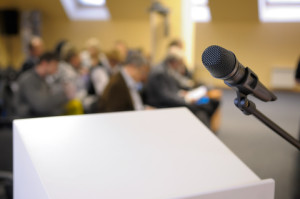
As presenters, people tend to fall into two opposing ‘choreography’ camps when they’re in front of a group – you may recognise yourself here:
- You stand stock-still (often hiding behind – even hanging onto – the lectern), barely twitching except to advance a slide
Advantage: you feel better because you’re in a safe space (or safer – of course it’s all relative!)
Disadvantage: it’s a boring, un-engaging look for your audience, and using so little physical energy is unhelpful for you too – if you’re nervous, that adrenalin and cortisol will ‘bank up’ in your system and perpetuate any physical symptoms of nervousness. Plus you won’t be able to access enough of the energy you need to get your message across effectively
2.You do the opposite and roam the floor: like a speaking nomad looking for a place to set up camp for the night.
Advantage: you’re burning off nervous energy, so you feel a bit better than if you were standing still
Disadvantage: it’s distracting after a while, and usually arouses low-level anxiety in the audience with your constant moving about
Do you recognize either of these two styles in yourself (or others)?
As you work on your speaking skills and get the fundamentals in place, like overcoming nerves and creating a solid core message and sticking to it, you can begin to work physical placement into your preparation. You deliberately work out where you’re going to stand, when to move upstage, or away from the lectern – and there’s a solid reason behind it…and then you practise the movements enough to make them look spontaneous.
Please note that I am not talking about rehearsing hammy, over-the-top gestures that look like you’re auditioning for a histrionic T.V. soap! Of course that’s just going to look stage-managed and fake. What’s important is to start learning about owning the space you’re speaking in, and using that space in the most effective ways to get your message across.
Action steps:
- Start by looking at other speakers when they present, or watching actors if you go to the theatre. Watch how they use and own the space, or not. And if they don’t, what effect this has on their message and presence.
- With your own presentation if you have one: get the overarching structure down on paper, and, focusing on your main points, actually mark in a few points where you’re going to move deliberately.
- Simply having a new awareness about your own style can help you to start incorporating some changes. If you’re a nomad, practise standing still occasionally; if a statue, try moving towards your audience during a key point and see how it feels.
- When do you want to be a little closer to your audience? When you’re interacting is a good time for this: asking questions or getting feedback
- When would it be good to move a few steps from one side of the stage to the other? As an example, when you’re giving one side of an argument, then the other
Then you need to physically practise those moves until they come naturally.
To sum up: physically owning your speaking space is another important key for good presentations, and a great way to create high audience engagement.
If you enjoyed this article, please share it on social media by using the buttons below – thanks!